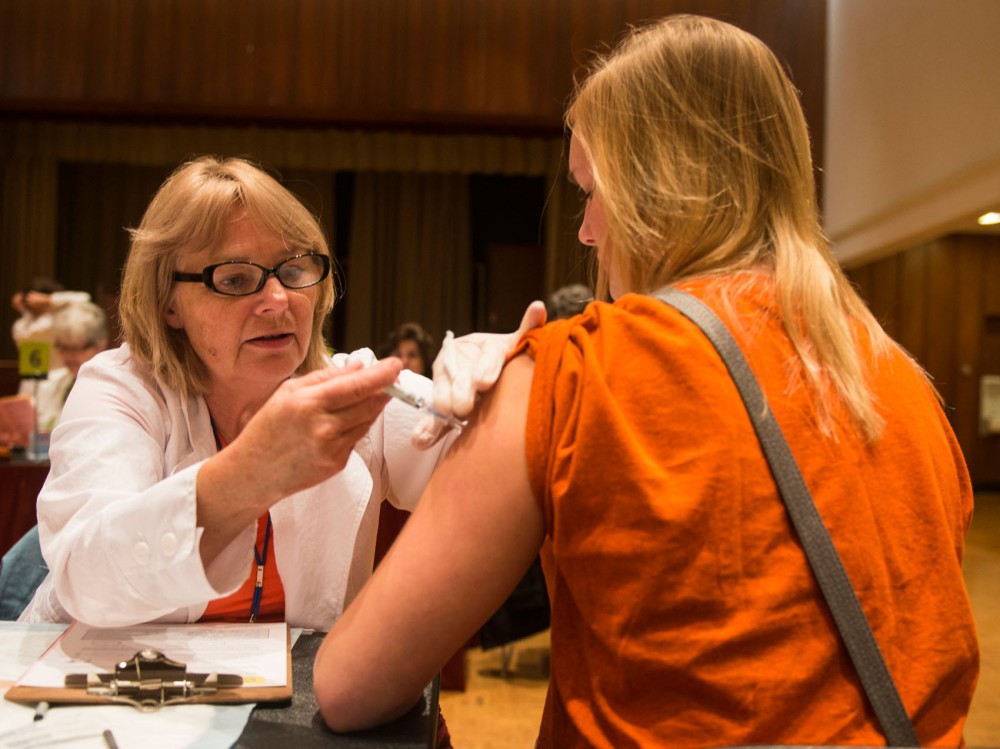This fall, a new flu vaccine will be available for free to University of Minnesota students, faculty and staff.
The quadrivalent vaccine can be administered as a nasal spray or an injection and fights more strains of flu virus than its traditional counterpart. Boynton Health Service will offer both types of vaccines at its free clinics this season, but the quadrivalent vaccine will only be available as a nasal spray and won’t be available in large quantities.
The traditional trivalent vaccine fights three strains of the influenza virus, said Dr. Dean Tsukayama, an infectious disease consultant at Hennepin County Medical Center. In contrast, the quadrivalent vaccine protects against four strains.
In the past, experts had to choose which of four influenza strains would be included in the vaccine each year, leaving patients unprotected against one, according to the Centers for Disease Control and Prevention.
There are two “A” strains and two “B” strains each year, and one of the “B” strains was always excluded. The quadrivalent vaccine now makes it possible to include four strains, though the trivalent still excludes one.
The new vaccine “may give broader protection,” the CDC said on its website, but the agency doesn’t recommend one vaccine over another.
Although the quadrivalent vaccine provides protection against more strains of the flu, it’s available in a limited quantity this year.
Manufacturers created about 137 million doses of influenza vaccine for this season, according to the CDC. Of these, less than a quarter are quadrivalent vaccines.
Shots or spray for students
Students, faculty and staff can sign up for vaccinations through the Boynton Health Service website.
Clinics will be held through mid-November at locations across campus.
Although individual vaccine doses cost about $10, BHS offers the vaccines for free to students, faculty and staff through the student services fee and the employee benefits program, said Dave Golden, BHS director of public health and communications.
Pharmacy students initiated the service in 2000, he said, and it has since expanded.
At some of the clinics, pharmacy and nursing students administer the shots to patients to gain experience, Golden said.
BHS clinics offer patients a choice between the injected vaccine and the nasal spray, though there’s not enough of the nasal spray for everyone, said Erin Lessor, BHS public health lead nurse.
But either vaccine gives “good protection,” she said.
Graphic design senior Yvonne Muller, who got a flu shot Thursday, said she heard there was a quadrivalent vaccine but wasn’t sure if students could ask for it.
She said she would like to get vaccinated via nasal spray if she could.
“Needles have always kind of freaked me out a little,” she said.
Animal science freshman Andrea Engstrom, who received her vaccine the same day, said she prefers a shot because it’s the “classic” way.
“I just like shots,” she said.
Last season, Golden said, BHS vaccinated about 20,000 students, faculty and staff, and the number keeps “creeping up.”
Golden said he would encourage the University community to take advantage of the free vaccines. That way, he said, they can protect themselves and also prevent transmitting the disease to others.
Last year, the CDC estimated 45 percent of people in the U.S. received flu vaccines.
Seasonal influenza-related deaths fluctuate widely each year — ranging from 3,000 to 49,000 over a 30-year-period — and nearly all of the deaths occur among people age 65 and older, according to the CDC.
“Influenza can be pretty serious,” Golden said. “We really want to slow down the spread of the virus.”








